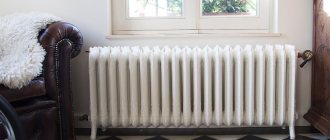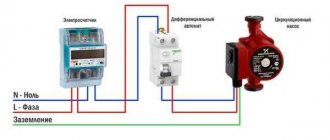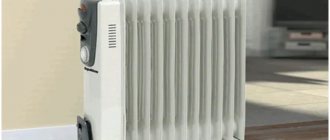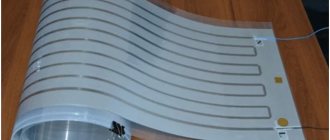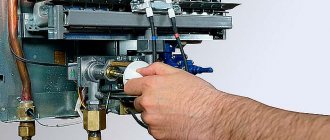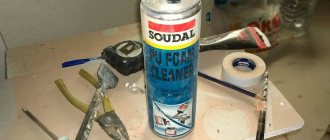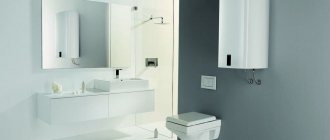Oil heating radiators will be indispensable assistants during the period when the air temperature in the room becomes too low and uncomfortable for living. They serve as additional sources of heat in the off-season, when the central heating system is not yet operating. The devices are used on cool days in the country house, country house, garage, construction trailer, etc.
Design and principle of operation of the heater
The operating principle and design of the oil heater are the same for all types of such devices. It is a sealed metal structure consisting of several sections. The working fluid is mineral oil, which is heated by a tubular electric heater located inside the device. The heated oil transfers thermal energy to the housing, which already heats the air in the room.
Understanding how a household oil heater works and works, it is much easier to decide on the choice of model.
Instrument design
The body of these heaters is made of metal and consists of hermetically joined sections. They are topped with a special durable powder coating that is not subject to mechanical stress. There is mineral oil inside the structure. Connect to the device:
- Thermostat.
- Heating element (heating element).
- Wires.
- Heating regulator.
- Special overlay panels.
Classification of oil radiators
Oil electric heating devices are classified as follows:
- Floor radiators. The most popular and widespread type of oil heaters. The device is equipped with special wheels for ease of movement. Often such devices are universal in terms of installation type, i.e. they allow the use of both floor mounting and wall mounting.
- Wall radiators. Using the brackets that come with these heaters, they are hung on the wall. Compared to floor-mounted structures, wall-mounted modifications are less powerful and have lower heat transfer.
- Baseboard heaters. The latest modified development of the device with wall mounting. The device is placed at the bottom of the wall, which ensures good air circulation. It is used as a full-fledged heat source, which is an alternative to central heating.
- Heaters with thermostat. In order to ensure uninterrupted operation of the device for a long time and reduce energy consumption, electronic thermostats are built into the heaters, maintaining the set temperature and eliminating possible changes.
- Heaters with fan. To speed up air heating, the devices are equipped with built-in fans, which additionally redistribute the flow of air masses. A negative point inherent in these varieties is the noise when the fan operates.
Classification and main characteristics
There are many oil-type radiators, which differ in the number or presence of additional options - built-in mechanisms, fans or place of operation.
Wall mounted
Models that can be attached to a vertical surface are called wall-mounted. They tend to be flatter and have non-protruding sections that do not interfere with the bracket's ability to catch on the hanging hooks. Often such modifications are universal - they have a place for screwing on wheels, which allows you to install them on the floor in the right place.
Floor-standing
This type is the most common and is popular due to its portability: if it is necessary to heat several rooms, it can be reinstalled with little physical effort.
The heat transfer of such a floor-mounted device is the highest. There is a separate subtype of floor models - baseboard heaters. They are installed in the corner of the wall and floor in place of the baseboard. They have a long and narrow shape.
Tabletop
Modifications that can be placed on a table are small in size and the same weight. They are designed to provide additional heating to a small room. Also used in the form of heating a children's room or crib.
The number of sections for tabletop types is no more than 5; the height of such sections is half that of floor ones.
For cots
Radiators designed for heating children's rooms differ, in most cases, in their appearance and mobility.
These can be either wall or tabletop modifications with bright colors. A significant advantage of using such a heating element is that the air does not dry out, and the humidity during battery operation is at least 60%, which is important for children who are often ill.
Children who often suffer from acute respiratory viral infections or chronic lung diseases - bronchitis, laryngitis, tracheitis - need constant air humidification. Fans that operate on the principle of a hair dryer cannot be used to heat a room - they heat up and move air around the room.
Advantages and disadvantages
Oil-fired electric heating radiators have a number of positive qualities, including:
- Compactness. These batteries take up little space.
- Mobility. Thanks to wheels, most models can be easily moved from room to room.
- Safety. The metal body does not heat up above +60…+70°C, which eliminates the possibility of burns and injuries. All working elements heated to high temperatures are located inside the casing.
- Silence. Oil batteries do not make noise during operation (except for models equipped with fans).
- They do not dry out the air in the room, do not burn out oxygen and do not emit unpleasant odors (compared to devices with open heating elements).
- Reasonable price.
- Easy to use. You just need to plug the cord into a power outlet and follow simple rules.
The disadvantages of such structures include the following qualities:
- Inertia. Mineral oil takes a long time to reach operating temperature (due to its large heat capacity) and the room heats up slowly. But the liquid does not cool down immediately, gradually releasing the accumulated heat.
- Quite a lot of weight and dimensions, which is not always convenient. The disadvantage is compensated by the presence of wheels.
Technical parameters of the oil device
During operation, some important requirements must be observed. The device must be stable and the cord must not be strained. Install in a place out of the reach of children or secure it. Avoid exposure to moisture. Do not operate near flammable materials. Do not use after the service life has expired.
Compliance with these rules will allow this useful device to work for a long time and bring joy to its owners.
Average score of ratings is more than 0
Share link
Comments There are no comments yet, but you could be the first...
How to choose an oil heater, which one is better
To understand which oil heater is better, you need to consider a number of important characteristics:
- Power. The most important parameter to choose from is the power of the heating device. It is believed that it is optimal to take heaters at the rate of 1 kW per 10 m² of area. It is recommended to purchase a radiator with a power reserve so that it does not constantly work at maximum and does not exhaust its resource too quickly. For rooms with a large area, it is better to take several low-power devices and place them in different places in the room than to use 1 powerful device. This way the heating will be more uniform.
- Width and thickness of sections. These indicators should have average values. Excessively thick sections take a long time to heat up, which directly affects energy costs. Narrow sections heat up faster, but have a small area and less heat transfer.
- Weight. Structurally, oil heaters cannot be lightweight. If a large-sized device has a suspiciously small mass, then you should not choose it. Such a device may be made of thin metal or the oil level in it may be lower than required.
- Power switch. The presence of different power modes, overheating protection functions and an adjustable thermostat significantly increases the efficiency of the device and reduces energy costs.
- Humidifier. Such heaters dry the air to a much lesser extent than similar heating devices. But with prolonged use, the humidity may decrease, so it is recommended to use devices equipped with a water container. This is especially important for residential premises (bedrooms, children's rooms, etc.).
- Built-in fan. To increase the heating speed, manufacturers equip heaters with fans that promote rapid movement of air flows. This way the heat spreads throughout the room more efficiently.
- Functionality and safety. The best oil heaters are equipped with overheat protection, a protective cover (for children's rooms), remote control and other useful features.
Tips and tricks for choosing
Radiators are produced with different power, which, among other things, depends on the number of sections: the more there are, the larger the heating area. The disadvantage of increasing the number of sections is the need to provide more space, which is difficult in small rooms. Although, such parameters for assessing characteristics are individual and this does not affect the mobility of equipment. In general, when purchasing an oil-type heater, pay attention to several features.
Continuous operation of the oil battery – 3 days.
Electricity consumption and the most energy efficient range
The convenience of oil radiators is obvious, but some buyers are confused by the energy consumption of such an installation - how much does the battery use per day? The power of the device is selected according to the size of the heated room. On average, heating 10 sq/m of space requires 1 kW of energy, if it is a living space with ceilings of 2.75-3 m. If the ceilings are higher, the calculation is carried out:
- The area of the room is calculated - the length is multiplied by the width.
- The volume of the room is determined by multiplying the area by the height.
- Divide the resulting number by 25 (because 25 m3 produces 1 kW).
- The result obtained is the heater power we need. If the quantity is very large, then you need to buy several radiators, which in total will provide the required energy
So, according to the above calculations, it turns out that for a room of 20 square meters. m, a 1.5 kW heater is suitable.
Dimensions and appearance (flat, small)
The height of one section is from 580 to 700 mm, width is 362-650 mm. The depth of the section to the central part is 90-290 mm. The number of such sections is 5-12, the most popular models with 9 or 11. They are flat, wide or narrow in shape. The smallest ones are plinth ones, their length is up to 1.5 meters, diameter is 50-90 mm.
The surface temperature differs from the maximum heating of the oil itself. So, if the oil is heated to a temperature of 60 degrees, then the surface of the sections heats up to 95°C.
Control
The control unit for oil convectors is located on the side of its end part. As a rule, this is a plastic panel with switches that control:
- operating modes;
- light indicators;
- humidifiers;
- shutdown sensors when the device overheats;
- duration of operation of the TEN;
- air heating temperature;
- Energy consumption;
- fan operation;
- duration of rest mode during continuous work.
Some modern models have LCD monitors with touch controls even from a distance.
Manufacturer and price - how to choose?
The range of products for heating autonomous rooms is large. Almost any household store has several manufacturers, but according to customer ratings, the most frequently purchased are:
- Vitesse VS-877.
- General Climate.
- Timberk.
- DeLonghi.
- Bimtek.
The price of radiators, depending on the number of sections and the manufacturer (domestic or imported), starts from 3 thousand rubles to 30 (for domestic needs, other amounts for industry).
How much electricity does an oil heater consume?
The main criterion by which you can calculate how many kilowatts an oil heater consumes is the power consumption of the device. The higher this indicator, the greater the energy consumption of the device. But the equipment does not always work at full capacity. How much a heating device consumes directly depends on the mode in which it operates.
If you take an oil heater whose electricity consumption is 2 kW, then at full power it will consume 2000 W. The thermostat periodically turns off the heating elements, so the operating time will be no more than 8 hours a day. The consumption will be about 16 kW per day. When you multiply this number by the current tariff (price of 1 kW), you get the cost of consumed electricity for 24 hours of operation. Based on these calculations, monthly consumption is calculated.
It is possible to calculate the cost of heating for a month or for the entire heating period if you know the power characteristic of each heating mode. Most often, the energy consumption of an oil heater is much lower than the maximum values due to the operation of the thermostat, which turns off the device when the desired temperature is reached.
For industrial purposes or for home: household or industrial
If for domestic needs there are a large number of offers at different prices, then for industry there is a separate line of products that differ in power, size and, accordingly, price. The maximum number of sections of one oil radiator is 14. For industrial premises, it is important not only their required number, but also their correct location. Thus, suspended models heat the air faster, and the power of the device must be at least 2.5 kW.
Oil for oil heater
The question of what kind of oil is in the heater rarely has to be decided, since these devices are always hermetically sealed to prevent evaporation and leakage of the working substance. During operation, replacement is required extremely rarely.
If depressurization occurs, then adding oil will not be enough; first you need to repair the housing and solder the leak. After the seal has been restored and if there is a technological hole for filling the liquid, it is possible to refuel or change the oil.
You can fill an oil heater with various transformer, mineral automobile (transmission) and sometimes even waste oils. It is important to remember that you should not mix oils of different origins in the radiator, as an unpleasant reaction may occur (a sediment will form, the composition will thicken, etc.). Only substances of identical composition may be added. It is not recommended to do this on your own. It is better to carry out repair work in specialized service centers.
Installation
Installation of the heater does not require special skills and knowledge. If it is a hanging model, it is mounted on brackets that are pre-installed at the required distance from each other. If the model is mobile on wheels, then all that is needed for installation is to determine the safest place near the outlet. It is worth considering that there should be no obstacles in the heater’s path - curtains, sofas or chests of drawers. It is best to install it in the central part of the room in the first 2-3 hours of operation. After the space has warmed up, it is moved to a more comfortable distance - near a wall or fireplace.
Why does the oil heater click?
Sometimes the oil cooler cracks during operation. If the device clicks when heating up, and the extraneous noise lasts no more than 3-5 minutes, then this can happen for the following reasons:
- Moisture (water vapor) has entered the sealed housing with oil. This can happen if the radiator was assembled in a damp room. When the appliance is turned off and the oil is cold, water condenses. When you turn on the device, the water heats up much faster than oil. A clicking sound is heard when boiling. When all the liquid turns into a gaseous state, the cracking stops.
- When the radiator is moved or accidentally dropped, the working fluid is shaken and mixed with air. When the device is turned on and the temperature rises, the air bubbles expand, increase in volume, and then rise up. When they burst, a clicking sound is heard. After the oil has completely warmed up, the sound disappears.
- Metal structural elements expand and crack when heated. Most often, the bimetallic switch in the thermal relay clicks. When heated, it opens, and when it cools to the required temperature, it closes again. This process is accompanied by a characteristic click.
Defects are extremely unpleasant, but there is no way to eliminate them. Such noises do not affect the functioning of the heater and therefore are not considered a defect.
If the alarming sounds do not go away after warming up, then the reason is more dangerous, since normal operation of oil radiators should be silent (excluding fan noise). This can be caused by electrical failures or defects in the casing. If the crackling noise lasts too long, the heater must be repaired. It is not recommended to try to repair the device yourself.
Main selection criteria
Choosing the best heater is a rather difficult task, the solution of which largely depends on the goals that the buyer has set for himself. But there are key criteria that I would like to draw your attention to:
An excellent addition to the room heating function is drying clothes, which can be problematic if the weather is bad outside and the radiators in the house are still cold
No. 1. Technical parameters. The main attention should be paid to the power of the device. This characteristic will be discussed further below. Here it is enough to mention that the power must be interconnected with the size of the room that needs heating.
We need a radiator to create comfort in the house, so preference should be given to a more powerful model. After all, it’s very disappointing when, after purchasing a low-power model, you continue to freeze. A fairly powerful product that has at least 2 heating modes, a temperature controller and a built-in thermostat deserves attention.
No. 2. Section sizes. Geometrically, the parameters of the device also matter. Narrow sections heat up faster, using less electricity for this process, but their total surface area is small. Therefore, heating the air in the room with their help will not happen too quickly.
Wide sections can be quickly cooled by air, so more electricity will be needed to heat them up. By choosing the parameters of the sections, you are essentially making a choice between the speed of heating the room and savings.
No. 3. Weight. Do not buy a device that is too light and has impressive dimensions. This effect can occur if the metal used to make the radiator is too thin or for some reason there is not enough oil in the device.
No. 4. Additional elements. In the off-season, when it’s already cold outside and it’s raining, and you haven’t even thought about turning on the heating, you need to somehow solve the problem of drying clothes. It cannot be placed directly on the heater, as on a regular radiator. But buying a device directly with a dryer is an excellent way out. It is better to ignore unnecessary options.
No. 5. Appearance. Any device must not only perform its assigned functions, but also be pleasing to the eye. If a designer has worked hard on the interior of your country house, it would be a shame to ruin all his efforts by purchasing an item that is discordant with the surrounding space.
Moreover, there is plenty to choose from: stores present to our attention models from different manufacturers, colors, shapes and sizes. There are also neutral products that can fit into almost any interior.
Thanks to relentless competition in the electrical goods market, a variety of heater models are appearing, which allows you to choose a product not only by its functions, but also by color, size and other parameters.
An oil heater is a device that should serve you for many years. When purchasing it, do not forget to correctly fill out all the documents that will allow you to apply for warranty repairs if such a need arises.
Skin and eyes suffer from room heaters
Dry air and low humidity negatively affect not only the respiratory system, but also the skin.
Subscribe to our INSTAGRAM account!
As a result of their work, heating devices evaporate moisture from the dermis that is already dry in the cold season. Lack of moisture causes it to itch and flake. Premature wrinkles also appear on it.
In addition, the eyes also suffer: under the influence of warm air, tears evaporate, which are necessary to moisturize the organ of vision. The balance needed for good eye health . Sooner or later this can lead to cataracts.
Features of operation and care
Oil heaters do not require extensive complex care or special maintenance. To clean the surface of the device, simply wipe it with a soft, dry cloth.
The oil heater does not cause any difficulties in operating and maintaining it: you just need to remember that it can only work in a vertical position, and also ensure that the shutdown timer is working properly
Abrasive agents cannot be used to clean it.
When using this type of heating device, some precautions should be taken:
- It should not be used in rooms where the humidity is high, unless the devices are equipped with special protection, information about which is included in the product passport.
- The power cord should not come into contact with the radiator body, as high temperatures can melt the insulation of the wire, and this is dangerous!
- The heater can only be operated when it is positioned strictly vertically; it must not be turned over!
- The heater must not be placed close to electrical equipment or a power outlet!
- When connecting equipment to the network, you should not use an extension cord, since during operation it may overheat and catch fire.
- The device must not be installed near furniture, textiles or other flammable or fusible materials.
- The radiator should be carried by holding it by the special handle: pulling it by the cord is prohibited!
- An oil heater cannot be stored on a balcony, in a garage or in a shed, because under such storage conditions it will fail early.
- Do not use the device in rooms designated for storing explosive materials!
- An oil heater can only be used for the period specified in the manufacturer’s passport.
- If the device is leaking, then do not rush to send it in for repair: it is better to buy a new one, because fresh coolant will no longer be pumped into the container, and due to the leak, its quantity now does not correspond to the declared technical parameters.
I would like to once again draw your attention to the dangers of improper operation of this electrical appliance. If you turn on an oil heater in the “lying” position, its hot oil can rupture the housing and cause a fire. After all, mineral oil does not fill the container to the top.
When the device is on its side, the heating element is partially exposed, which means it is in contact with an oxygen-aggressive environment. The operating temperature of the heating device will then increase and the coolant will begin to burn out.
Soot will appear on the walls inside, preventing normal heat transfer. The device will have to work with increased load, which is why it will fail much earlier than the manufacturer promised.
It is also undesirable for the heater to operate when its overheating sensor is faulty. In this case, heating will not be interrupted when the maximum critical temperature is reached. The device will not turn off, but will heat up until it burns out.
The worst forecasts promise a fire that will develop into a fire if no one stops it in a timely manner. A fire hazard can be created by items hung to dry on an oil radiator.
The heater can easily overheat and cause a fire. The same consequences will be caused by foreign objects in the outlet and ventilation openings. If you listen to our advice, then buy a high-quality and reliable device that will serve you for many years, always helping you out when the need arises.
Heating devices are harmful for allergy sufferers
If you suffer from allergies to dust, pet hair and other irritants, then think a hundred times before buying a household heater . So, in addition to heating the air, a fan heater spreads dust around the room, which can cause an allergic reaction.
In addition to allergies and the suffocating effect, fan heaters also cause headaches and irritation. After all, such electrical appliances are very noisy when operating.
In addition, very dry air and low humidity lead to the so-called “suffocation” effect: when the room is heated by a heat fan, it seems that you simply cannot breathe and you want to open the window as soon as possible to take a breath of fresh air. But a sharp transition from heat to cold can lead to another problem - a cold.
Therefore, if you can find another alternative to keep warm, use it. And if not, then install a humidifier, ventilate the room often and do wet cleaning.

